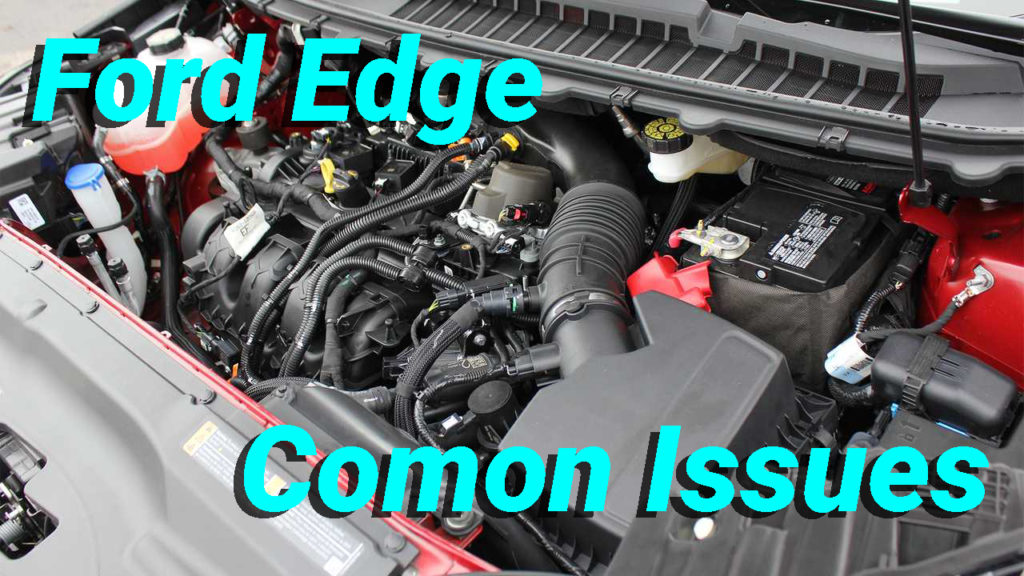Taking the title of best-selling SUV of auto giant Ford and having great versatility and space, Ford Edge is quite an affordable vehicle with exceptional features and specifications. The reliability is the real question, though. Debuting in the year 2007, its sales have been skyrocketing since then. From a commodious cargo compartment to flexible seating, from all-wheel drive to the exterior, it has made everything perfect so that the passengers have a remarkable driving experience. Whether it is muddy ruts or either snowed roads, it provides you with the ultimate confidence to have a safe drive without hesitation.
However, if you are thinking of purchasing a Ford Edge, you need to dig a little deeper and check for its maintenance and recalls. You need to be fully aware of what possible issues this vehicle causes.
Common Issues with Ford Edge

If you are considering purchasing a used Ford Edge, then you should know about these few issues. The common ones are the following:
- Door sensors might be faulty. This is usually the case with first-generation vehicles.
- The steering motor might have corroding bolts
- Engine failures get prevalent after the warranty of the powertrain expire
- Start/stop accumulator having bad assemblies.
- The design of the engine compartment is very poor.
These are a few common issues with engine problems being the major ones. The engine problems result in overheating together with engine fires and sometimes misfiring.
Engine integrated into Ford Edge

There are various engines that people can opt for when purchasing a Ford Edge for themselves. The engines can be upgraded to 3.5-liter powerful V6 engines or either a twin-turbo 2.7 Liter. This article will be discussing the 2.0 engine since it caused major issues and has got the most complaints.
To start off with the better things, the engine offers exceptional fuel economy. This was made possible through a start/stop system installed. Let’s put a torch on major issues experienced through the engine.
Ford Edge Engine Problems – The Most Highlighted Ones

The leaking of coolant is found to happen in the Ford Edge which can result in so many other issues. It can lead to unfortunate circumstances and this needs to be controlled. Let’s dive in and get to know about common Ford Edge engine problems.
Overheating

The faulty engine is going to be a big issue for you. The leaking coolant will be subject to overheating. The leaks will make the engine out of coolant which will be an inevitable cause of overheating.
Initially, when the leak is a minor one, you will drive around comfortably and that won’t be a big issue. This, however, stays long. There is a high possibility of a minor one converting into a major one. If that happens, the car will be subjected to overheating causing additional problems. Overheating can be a major issue and one should not drive Ford Edge when overheated.
Symptoms
Following are some common symptoms that can lead to overheating:
- Coolant leaking
- Ticking noise
- Thumping noises
- Engine power is highly reduced
- Hot hood
Solutions
In a situation where your car gets overheated, you should pull it over to the side and not try driving it anymore until checked by the mechanic. If you have turned on the AC, it should be turned off immediately. Add some coolant and afterward, ignite your car to take it straight to the mechanic.
Following are some solutions which can be adopted to get your car’s engine overheating fixed:
- Refilling of cooling system
- Installing new and reliable radiator cap
Low oil pressure

This is probably the most critical thing which your Ford Edge can encounter. The seizing up of the engine will be due to the low pressure of oil. The locking up will become inevitable as soon as the oil pressure indicator lights up. The engine shouldn’t be ignited until the issue gets completely fixed.
Causes of low oil pressure
There are multiple causes that result in such a serious issue. Below down are the common ones.
Lack of oil
The most obvious reason is that your vehicle is out of oil or if not, the oil is insufficient. This calls for checking if the oil is right on the level. If found low, the oil needs to be filled up. In case you do not have the oil with you, you are strongly advised to keep the engine shut and not drive off your vehicle to get the oil. This would do more harm than good. The high pressure will result in the locking up of the engine if the vehicle is driven without enough oil.
Oil pump being bad
The oil pump’s job is to get the oil stored in the oil pan and make it pump up through the engine of your Ford Edge. The wearing of an oil pump will definitely affect the efficiency of oil being pumped making it less effective. The oil pumps are usually secured with a screen provided for the sole purpose of restricting large debris. Small particles eventually do enter and they can prove to be really bad for pump capacity.
Air particles in oil
Aeration of the oil is another major cause. If the level of the oil in the pan drops low, the oil will be saturated with air particles. This can be thought of like foam gathered on top of beer. This all has to do with the oil level therefore it shouldn’t get lowered or raised. Keep checking if the oil is right on its given level.
Dirt in engine
Dirt in the engine is the result of the negligence of not checking oil regularly. This will get so much dirt in the engine as well as in the oil that the oil won’t circulate as it should. The cycles will be affected and so will be the pressure dropping low.
Regular checkups are therefore recommended. Towing as well as overdue oil change might cause this issue. Change of oil may help with the issue significantly. Don’t forget to make the oil change services regularly.
Clogged filter
Modern engines have this problem solved. Even when the filter gets clogged, the oil keeps flowing using the provided bypass filter. In case there is resistance through the filter, the value gets activated. The passing of a large amount of oil through this value will switch on the oil light indicating some issue.
Pickup tube
This tube carries the job of taking the oil up to the integrated oil pump from the oil pan. The tube is not properly oriented or either subject to falling and the oil won’t reach the required position. This can cause low oil pressure.
Diagnosis of Ford Edge engine low oil problem
You can follow below listed steps to diagnose the low pressure of oil.
Oil level check
The oil level should be checked regularly as that will ensure if your vehicle has the oil and that will result in smooth running. In case the oil drops below the required level, it can be restored back by putting in the necessary amount. A lot of problems will be solved this way. The frequent leaks demand frequent checking.
Checking the sending unit
The recently manufactured vehicles have a sending unit integrated which is electrical in nature. The sensor displays the oil pressure reading. If your Ford Edge is displaying a reading indicating low pressure, then there is a possibility that the sensor is not working properly. The first course to adopt is to change the sensor integrated because that might be indicating false reading.
Mechanic
Rest should be left to mechanics as they better know what to do with your Ford Edge. The engine might be blown due to oil pressure being low which is undesirable. Take your Ford Edge to the mechanic to fix the problem completely.
Misfire

The engine problem doesn’t stop here. Another Ford Edge engine problem is misfiring. This will feel like the SUV is trying hard to stop and won’t speed normally when you will be accelerating it. Driving at a faster speed will result in the shaking of the car. If this goes on, the light will be switched on indicating some issue with the engine and misfiring.
Symptoms
· Rough idling- The engine will result in idling roughly.
· Sluggish acceleration- The car won’t speed adequately
· Change of sound- The sound will go louder and deeper indicating misfiring
· Black exhaust
· Light is switched on
Solution
As soon as you get to know about the vehicle misfiring, you should pull the vehicle off to a safe place.
The most probable things you could adopt to eliminate misfiring in Ford Edge are following
· Replacing spark plug
· Gapping spark plugs appropriately
· Replacing the head gasket
· Engine rebuilt
Ford Edge Engines Affected

3,496 cc (213.3 cu in) 3.5 Duratec V6 Engine
Model Years 2007-2010 – Engine Power 265 bhp (198 kW) at 6,250 250 lb⋅ft (339 N⋅m) at 4,500
Model Years 2011-2014 – Engine Power 285 bhp (213 kW) at 6,500 253 lb⋅ft (343 N⋅m) at 4,000
3,721 cc (227.1 cu in) 3.7 Duratec V6 Engine
Model Years 2011-2014 – Engine Power 305 bhp (227 kW) at 6,250 280 lb⋅ft (380 N⋅m) at 4,500
1,999 cc (122.0 cu in) Ecoboost I4 Engine
Model Years 2011-2014 – Engine Power 240 bhp (180 kW) at 5,500 270 lb⋅ft (366 N⋅m) at 1,750–4,500 rpm
1,999 cc (122.0 cu in) Ecoboost I4 Engine
Model Years 2015– Engine Power 245 bhp (183 kW) at 5,500 rpm 275 lb⋅ft (373 N⋅m) at 3,000 rpm
3,496 cc (213.3 cu in) Duratec 35 V6 Engine
Model Years 2015-2018 – Engine Power 280 bhp (210 kW) at 6,500 rpm 250 lb⋅ft (339 N⋅m) at 4,000 rpm
2,720 cc (166 cu in) 2.7 Ecoboost V6 Engine
Model Years 2015-2018 – Engine Power 315 bhp (235 kW) at 4,750 rpm 350 lb⋅ft (475 N⋅m) at 2,750 rpm
Model Years 2019– Engine Power 335 bhp (250 kW) at 5,550 rpm 380 lb⋅ft (515 N⋅m) at 3,250 rpm
2.0 L (120 cu in) TDCI I4 Engine (Europe)
Model Years 2016-2018 – Engine Power 180 bhp (130 kW) at 3,500 rpm 295 lb⋅ft (400 N⋅m) at 2,000-2,750 rpm ( Available only with a 6-speed manual transmission )
2.0 L (120 cu in) TDCI I4 Engine (Europe)
Model Years 2016-2018 – Engine Power 210 bhp (160 kW) at 3,000-4,500 rpm 332 lb⋅ft (450 N⋅m) at 2,000 rpm ( Available only with a 6-speed PowerShift dual-clutch transmission )
2.0 L (120 cu in) EcoBlue I4 Engine (Europe)
Model Years 2018– Engine Power 190 bhp (140 kW) at 3,500 rpm 295 lb⋅ft (400 N⋅m) at 2,000 rpm ( Available only with a 6-speed manual transmission )
2.0 L (120 cu in) EcoBlue I4 Engine (Australia)
Model Years 2018– Engine Power 190 bhp (140 kW) at 3,500 rpm 295 lb⋅ft (400 N⋅m) at 2,000 rpm ( Available only with 8-speed automatic transmission )
2.0 L (120 cu in) EcoBlue I4 Engine (Europe)
Model Years 2018– Engine Power 238 bhp (177 kW) at 3,750 rpm 369 lb⋅ft (500 N⋅m) at 2,000 rpm ( Available only with 8-speed automatic transmission )
Conclusion

Besides being one of the best-selling cars, Ford Edge does have some major engine issues and they need to be dealt with properly. Low engine pressure being the most serious of the engine problems needs to be treated early and perfectly. Along with following all the solutions stated above, the best course is to take it to the mechanic to get the engine problems fixed.



